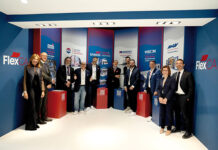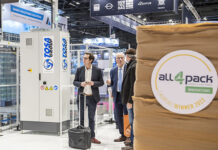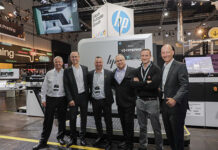Founded just a few years ago, today BFT Flexo, which is part of the BFT Group, is already an established company in the printing and converting sector, aimed at greater standardization of the process, cost control and reduction of environmental impact
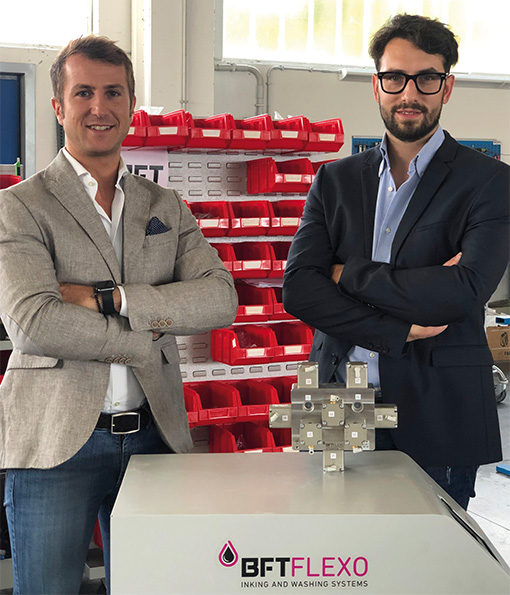
A young company, formed by young engineers but with a great richness of skills in the field of printing technologies, able to solve from the simplest problems to the most complex ones with innovative, high-performance technological solutions, with a proven return on investment, thanks to a totally controlled process with results demonstrated by numbers, and not least with low environmental impact, with a reduction in energy and material consumption. We are talking about BFT Flexo, part of the BFT Group which also includes BFT Carbon (a company we are talking about with a dedicated article on Converter & Cartotecnica September / October – ed.) A company founded only three years ago by two young engineers who in their respective family companies have always had to do with the world of printing. In a short time they have achieved remarkable results, with installations on production lines of the most important world groups in the printing & converting sector.
Reduction of waste thanks to an innovative inking and washing system
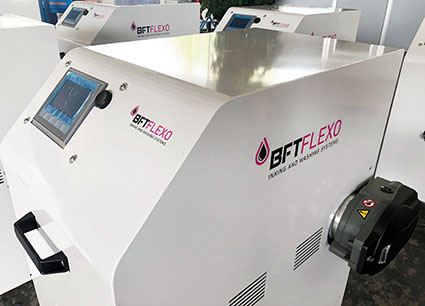 “Visiting printing companies, I realized the inefficiencies related to inking systems, with important wastes of both ink and washing water. To solve these problems, it was essential to combine knowledge of automation and industrial hydraulics to develop a product that was able to solve these problems”, says Simone Bonaria, BFT Flexo operating director.
“Visiting printing companies, I realized the inefficiencies related to inking systems, with important wastes of both ink and washing water. To solve these problems, it was essential to combine knowledge of automation and industrial hydraulics to develop a product that was able to solve these problems”, says Simone Bonaria, BFT Flexo operating director.
After a year of development, the first solutions were tested on the US market, an experience that leads to further improvements that guided the company towards the definitive solution, able to stand out as highly performing and innovative.
“The inking and washing system we have designed is very flexible and can also be managed as an integrated part of the printing machine itself that can control it directly”, says Alberto Ferrara, BFT Flexo technical director.
Partnerships with manufacturers
T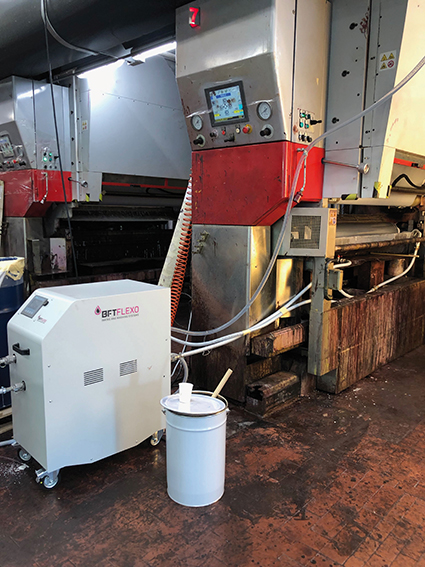 his solution is mainly created for the flexible packaging market, where color change must be carried out as quickly as possible. The first installations of BFT Flexo systems were carried out directly by the printers, as an up-grade on existing lines, but the real qualitative leap came when started the direct relationship with manufacturers of printing and converting machines. “For a world leading manufacturer, we started building washing systems based on their projects, but in a short time we realized that we could not get the performance we had experienced elsewhere with our systems. We therefore proposed a new solution, entirely designed by us and perfectly integrable with their solutions, and we were able to obtain important results in terms of less waste of raw materials and resources, actually reducing costs, a very sensitive element for those who build machines”, adds Bonaria.
his solution is mainly created for the flexible packaging market, where color change must be carried out as quickly as possible. The first installations of BFT Flexo systems were carried out directly by the printers, as an up-grade on existing lines, but the real qualitative leap came when started the direct relationship with manufacturers of printing and converting machines. “For a world leading manufacturer, we started building washing systems based on their projects, but in a short time we realized that we could not get the performance we had experienced elsewhere with our systems. We therefore proposed a new solution, entirely designed by us and perfectly integrable with their solutions, and we were able to obtain important results in terms of less waste of raw materials and resources, actually reducing costs, a very sensitive element for those who build machines”, adds Bonaria.
Industrial automation for controlled fluid management
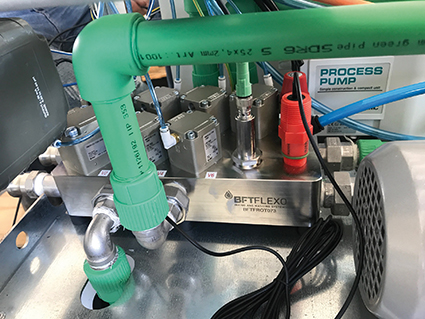 The systems for fluid management, for printing inks or glues for coating and laminating flexible films, proposed by BFT Flexo are all managed by industrial PLCs, through which it is possible to control the whole system, including those auxiliary equipment of the machine that until today were managed manually, such as doctor blade pressure, tracing the control and providing statistics to get a precise data on duration of each component, the quantity of ink in circulation and subsequently recovered, the amount of water used for washing, allowing the entrepreneur to be able to accurately calculate this phase of production. “These data also provide a history that can be useful for subsequent processing, under the same conditions, for a process that is truly standardized, effectively eliminating human variables that can cause errors”, adds Alberto Ferrara.
The systems for fluid management, for printing inks or glues for coating and laminating flexible films, proposed by BFT Flexo are all managed by industrial PLCs, through which it is possible to control the whole system, including those auxiliary equipment of the machine that until today were managed manually, such as doctor blade pressure, tracing the control and providing statistics to get a precise data on duration of each component, the quantity of ink in circulation and subsequently recovered, the amount of water used for washing, allowing the entrepreneur to be able to accurately calculate this phase of production. “These data also provide a history that can be useful for subsequent processing, under the same conditions, for a process that is truly standardized, effectively eliminating human variables that can cause errors”, adds Alberto Ferrara.
A compact and easy to maintain system
Even the compact dimensions of the system proposed by BFT Flexo have made the difference, making it easier to insert them into printing machines. Thanks to collaborations with its partners, such as SMC and Siemens above all, BFT Flexo was able to develop a valve system integrated in a single block of stainless steel, facilitating cleaning and maintenance. “Our compact system uses 7 valves, but we have seen other systems with over 20 valves mounted on machines, scattered in different points of the machine, which greatly complicate maintenance operations in case of failures. Furthermore, our system is set up to carry out washing cycles automatically, because it is important to clean the printing machine, but it is also important to keep the inking and washing system efficient and clean. In addition, we have also implemented a washing phase of the pipes on bucket side and not only on machine side, in order to avoid contaminations that would then force to throw away ink bins”, says Alberto Ferrara.
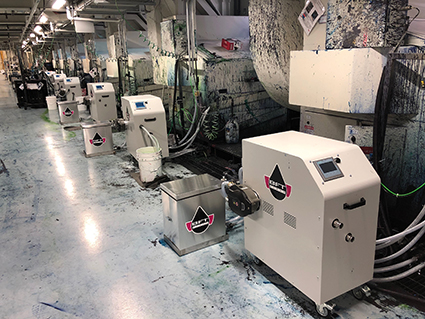 BFT Flexo systems can be used both with water-based and solvent-based inks; in both cases a pre-wash is carried out with the liquid, water or solvent, semi-dirty, which is used for a first high-pressure wash cycle, where the force with which the washing is carried out is more important, and a second phase of washing with water taken from the water net and then re-stored in the semi-dirty water tank, allowing a 50% water saving. Inking and washing systems, with ink temperature control, are also great news, dedicated to gravure sector. Reading and controlling temperature, both in gravure and flexography, is essential for process standardization. For water based systems, Ph control is also available.
BFT Flexo systems can be used both with water-based and solvent-based inks; in both cases a pre-wash is carried out with the liquid, water or solvent, semi-dirty, which is used for a first high-pressure wash cycle, where the force with which the washing is carried out is more important, and a second phase of washing with water taken from the water net and then re-stored in the semi-dirty water tank, allowing a 50% water saving. Inking and washing systems, with ink temperature control, are also great news, dedicated to gravure sector. Reading and controlling temperature, both in gravure and flexography, is essential for process standardization. For water based systems, Ph control is also available.
“We have many projects in development and also thanks to our partners, with whom we have great harmony, we will continue to invest in research and development to provide the market with high-performance solutions at competitive costs and above all to make the printing machine more and more intelligent”, concludes Simone Bonaria.






